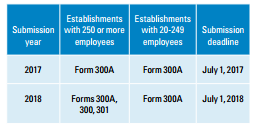OSHA’s Updated Electronic Recordkeeping Rule: Are You Prepared?
OSHA has updated their recordkeeping requirements for employers across many different industries in an effort to ensure the completeness and overall accuracy of injury and illness information.
The update requires employers to inform employees of their right to report work related injuries and illness free from retaliation, clarifies the requirement for employers to establish a documented procedure for reporting and managing work related injuries which do not deter or discourage reporting, and includes an updated statute prohibiting employers from retaliating against employees who report work related injuries and illnesses.
Of particular note, the new rule, which took effect January 1, requires specific employers in pre-identified industries to electronically submit their injury and illness data. The required information for electronic submittal includes the same data that employers are already collecting and reporting annually on the OSHA injury and illness forms. OSHA will analyze and publically publish the information submitted by employers with the intent to motivate employers to improve health and safety performance. The database of public injury and illness information will allow businesses to benchmark their performance against others in like industries. The accessible data will also allow potential employees, customers and the public to see where health and safety of workers stands within businesses.
The updated electronic reporting requirement is being phased in over the next two years. OSHA has separated the affected establishments into two categories: employers with 250 or more employees, and employers with 20-249 employees in high risk industries which are classified by an industry NAICS code.

OSHA states that the total number of employees is based on a single physical location where operations are conducted or services are provided. The total employee count must consider an establishment’s peak employment during the reporting year which includes seasonal, temporary and part-time workers. As an example, if your business is not in a high risk industry and has 400 employees in four different locations with 100 employees in each location, then electronic reporting is not required. Subsequently, if your business is in a high risk industry and has 50 employees in two locations with 40 employees at one location and 10 employees at the other, then electronic reporting would be required only for the operation with 40 employees.
During 2017, the first year of implementation, employers who fall into either of the above categories must submit 2016 data recorded on the 300A form electronically by July 1, 2017. During the second year of implementation the same employers must submit 2017 injury and illness data contained on all three OSHA forms (300A, 300 and 301) by July 1, 2018. Beginning in 2019, those employers will be required to annually report all OSHA forms electronically by March 2.
Once you have made the determination on your establishment’s reporting requirement applicability, you need to know where you can submit your information. OSHA has stated that there will be three options available for submitting data: manual data entry via web form, upload of a single CSV (excel type) file which will allow for the submission of multiple site information, and transmission of electronic data through a custom software application available from OSHA. The site is scheduled to launch in full in February, however OSHA has already released the CSV template and information on the software application.
It is worth noting the potential impact of the recent memorandum issued by the Trump Administration related to federal agencies sending new regulations to the Office of the Federal Register. This may “temporarily postpone” the implementation of this, and other, OSHA regulations.
According to Mark Ames of the American Industrial Hygiene Association, “…the White House issued a regulatory freeze impacting all pending regulations—including final rules that have yet to be fully implemented… This seems straightforward, but there’s actually a lot of vague language in the memo that can be interpreted in multiple ways, making the specific impacts on worker health and safety hard to predict. While agencies are rushing to provide guidance on which rules are subject to the freeze, this period of regulatory disruption is likely to continue for some time, even after President Trump’s nominees have been installed, since the president has ambitious plans for cutting federal regulations, creating additional vast uncertainties.”
Nevertheless, bringing your company into compliance with this and all proposed regulations is likely the right path to take at this time.
For more information see the resources below.
OSHAs Recordkeeping Webpage and Frequently Asked Questions
OSHA Fact Sheet – Final Rule to Improve Tracking of Workplace Injuries and Illnesses
OSHA Fact Sheet – Who is Required to Keep Records and Who is Exempt

